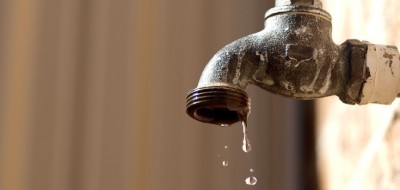The Privatization of Water in India: How Coca-Cola Destroys the Aquifer
Never Mind the Greenwash - Coca Cola Can Never Be 'Water Neutral'

Following a series of disastrous failures in India, one of Coca-Cola’s most important markets, the company is desperate to rebuild its reputation by claiming ‘water neutrality’. But the idea is absurd, writes Amit Srivastava, and does nothing to benefit the communities that suffer from the depleted aquifers it pumps from.
The Coca-Cola company is planning to announce that it is close to replenishing all the water it uses“back to communities and nature” by the end of 2015, well ahead of schedule.

It will take more than PR puff to restore Coca-Cola’s reputation in India. Wall-painted sign in Bangalore, India. Photo: Syed Nabil Aljunid via Flickr (CC BY-NC).
As campaigners that have closely scrutinized Coca-Cola’s operations in India for over a decade, we find the company’s assertions on balancing water use to be misleading.
The company’s track record of managing water resources in and around its bottling operations is dismal, and the announcement is a public relations exercise designed to manufacture an image of a company that uses water sustainably – far removed from the reality on the ground.
The impetus for Coca-Cola to embark upon its ambitious water conservation programs globally stems from its experience in India, where the company has been the target of communities across the country holding it accountable for creating water shortages and pollution.
The company has faced crisis in India due to their mismanagement of water resources, including
- the forced closure of their bottling plant by government authorities in Kerala in 2005,
- the closure of its 15 year old plant in Varanasi last year,
- the refusal by government authorities to allow a fully-built expansion plant to operate in Varanasi in August 2014,
- a proposed plant in Uttarakhand cancelled in April 2014,
- and the withdrawal of the land allocated for a new bottling plant by the government in Tamil Nadu due to large scale community protests in April 2015.
Coca-Cola’s operations in Jaipur in India are also now used as a case study in colleges and universities on the company’s profound impact on water resources.
The myth of ‘water neutrality’
The suggestion that the world’s largest beverage company can become “water neutral”, as Coca-Cola has suggested, is impossible and deceptive, as the India Resource Center has pointed out in the past. It is not possible for a company whose primary raw material is water, to have ‘neutral’ impact on water resources.
Such a disingenuous suggestion by the world’s largest beverage company is a disservice to the public, and without admission of the massive impact the company has on water resources, there can be no genuine discourse with Coca-Cola on water management.
The company’s claims of having ‘neutral’ impact on water resources are misleading for two principal reasons.
First, water issues are local in their impact unlike, for example, climate change. When Coca-Cola extracts water from a depleted aquifer in Varanasi or Jaipur, the impacts are borne by the local communities and farmers that depend upon it to meet their water needs.
Replenishing an aquifer hundreds of miles away from the point of extraction, as Coca-Cola has often done to ‘balance’ their water use, has no bearing on the health of the local aquifer which Coca-Cola depletes through its bottling operations, nor the privations suffered by those who depend upon it.
Second, the amount of water used to make Coca-Cola products, referred to as the ‘water footprint’, is much more than the water used in the bottling plants. Cane sugar is a major component of Coca-Cola products in India, and as one of the largest procurers of sugar in India, Coca-Cola is well shy of achieving any balance with the water used the production of its sugar sweetened beverages.
The Water Foot Print Network has estimated that it takes 442 liters of water to make one liter of Coca-Cola using cane sugar, and 618 liters of water to make one liter of Coca-Cola product using High Fructose Corn Syrup.
These astounding numbers are not factored into the water replenishment announcement, and Coca-Cola’s claims fall flat if they were to be included – as they ought to be. The numbers used for their announcement are about 200 times less than the actual water footprint of Coca-Cola products.
No more pumping of depleted aquifers!
One of the continuing challenges being faced by communities across India is that the Coca-Cola company has continued to operate its bottling plants in severely water-stressed areas, as well as propose new plants in water-stressed areas where the communities have very limited access to potable water – a fundamental human right.
Any company that wants to establish itself as a responsible user of water would begin by not operating in water stressed areas, a demand that has been made of Coca-Cola but which the company seems to ignore because it will deprive it of profits and access to markets.
Coca-Cola is in the habit of making tall claims and generating false opinions favorable to its own cause, whether it is on water use or public health, and this announcement on water replenishment is just that. Just last week, the company was exposed for setting up a front group, Global Energy Balance Network, to confuse the science around obesity.
Attempting to confuse and mislead regulators and scientific opinion is not new to Coca-Cola. In 2006, one of Coca-Cola’s lobbyists in India admitted that his job “was to ensure, among other things, that every government or private study accusing the company of environmental harm was challenged by another study.”
If Coca-Cola truly wishes to rebuild its reputation in India and mitigate the massive environmental damage caused by its operations, it must stop the greenwashing, stop exploiting depleted aquifers, and engage seriously with its critics and impacted communities.
Amit Srivastava is director of India Resource Center, an international campaigning organization.

